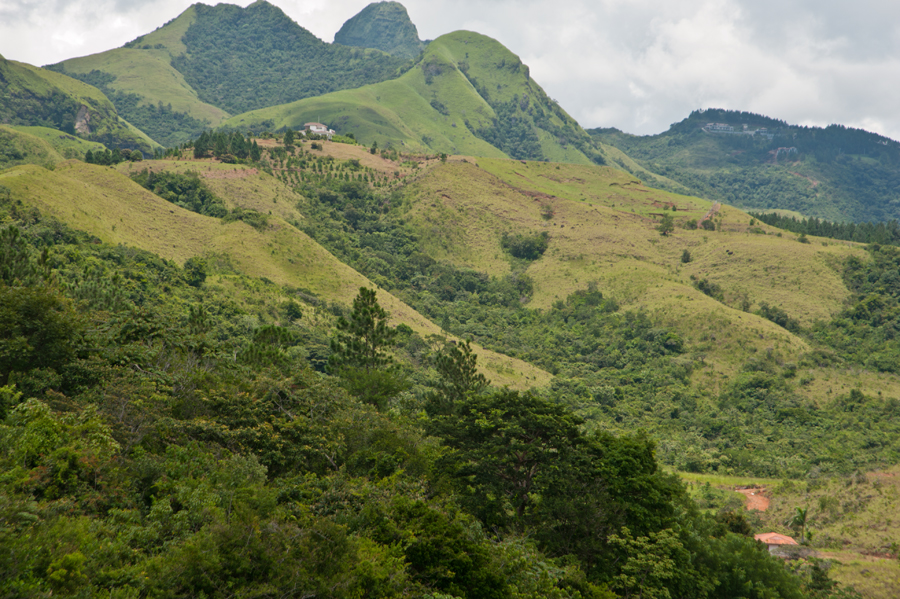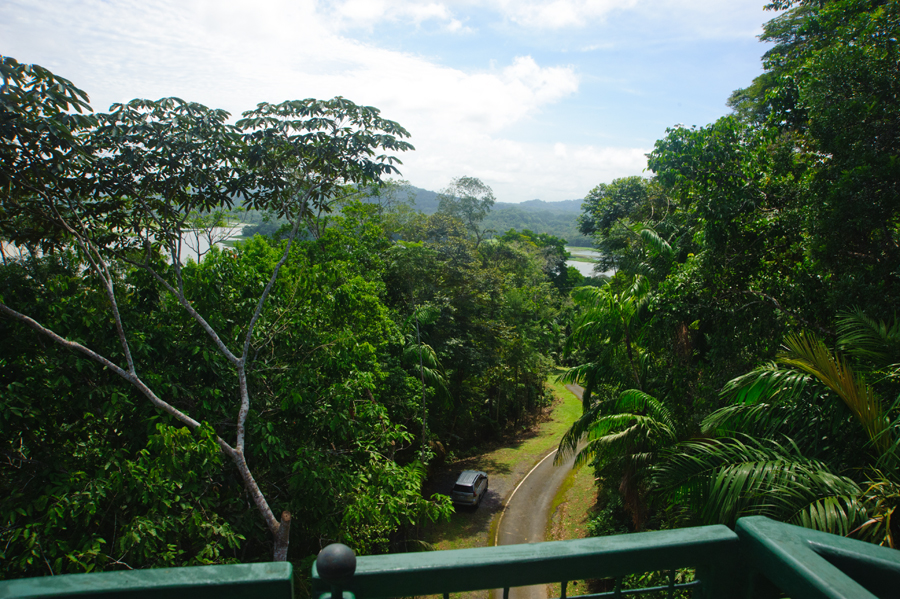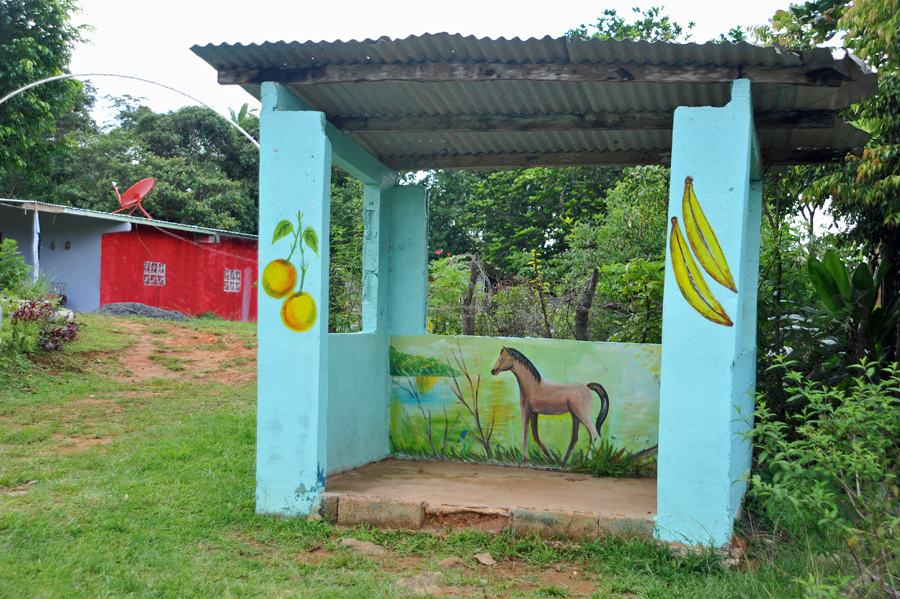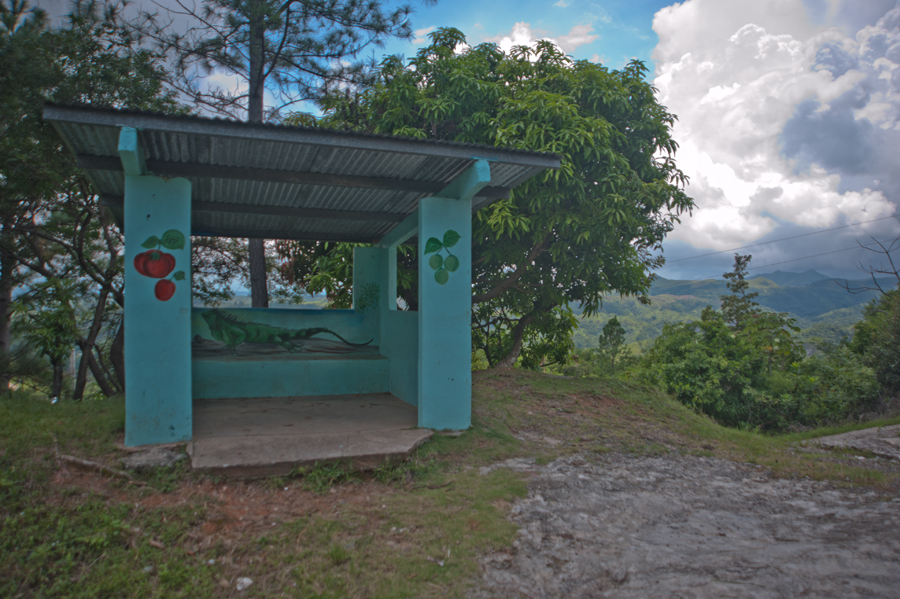A visit to the Gamboa Rainforest Resort proved to be a fun day. The resort is a favorite for eco-tourists. As you would expect by the name, it is set in the rainforest on the Chagres River. The hotel offers all sorts of tours for guests and visitors. The attractions that really got our attention were a tram ride over the rainforest canopy and a nature tour that included a sloth sanctuary, orchid farm, butterfly nursery, and frog pond. We purchased a package of these tours for $50 each.

The first time we have seen leaf cutter ants in the wild – The guy operating the tram thought I was a little crazy to take a picture of ants.
The tram leaves the resort and for about 15 minutes silently carries people over the rainforest canopy to a hilltop. At the top of the hill, we walked the short trail to an observation tower offering magnificent views of the rainforest, Panama Canal, the Chagres River and the town of Gamboa below. The walk up the tower was not too difficult but because of the heat, I was happy to find chairs at the top. I took time to sit, take in the view and enjoy a breeze. I caught my breath and listened to the little portable tour-player they gave us with information about the sights. When the breeze picked up, I could feel the tower sway. Cindy was the smart one. She stayed below. She doesn’t do towers. At this point, I am starting to wonder how far the tower sways before it topples.
I had to laugh at a couple of things mentioned on the self-guided tour headset. It talked about how the bathrooms at the base of the tower had to be permanently closed due to rainforest critters lurking about inside waiting to freak out tourists. I can’t help but wonder how many people died. It also mentioned frogs. At times, there are so many frogs at the base of the tower on the cement foundation the noise is unbearable. Nobody really knows why the frogs like to hang out on the concrete. We didn’t see any frogs. Perhaps they were all inside the bathrooms.
I really have a fondness for sloths. What is not to like about a critter who moves at the speed of molasses is fury and cute (kind of like koala bears). I learned some new tidbits about them at the sanctuary. Sloths only come out of the trees onto the ground about one day a week. This is when they drink and poop. Otherwise, they spend their time hanging about upside-down sleeping. They sleep for 18 hours per day. When they are awake, they eat. What a life! The only time a sloth will ever move quickly is when it starts to rain. They hate getting wet because it makes their skin itch and will seek cover under the thickest part of the tree. In Panama, there is an ongoing campaign to educate people wishing to help sloths when they see them crossing roads. They discourage people from picking them up and holding them like a baby. It is best to grab some fur behind the neck and carry them at arm’s length. This is not because the sloths don’t like to be carried like babies. It is because sloths have all sorts of bugs living in their fur. Maybe not so cute after all, huh?
Outside of the sloth sanctuary, a couple of sloths moved into some nearby trees. The staff took time to point them out as we toured the facility. Several of the sloths are permanent residents of the sanctuary due to injuries. The sloth hospital tries to return sloths to the wild if possible. I guess the wild sloths outside figure good healthcare is close by should they lose their grip and fall.

Aren’t I cute – This right-side-up sloth is missing a toe so it’ll be in the sanctuary forever since it can’t hang about properly
The frog pond is an attempt to rescue Panama’s national symbol, the Golden Frog (which is technically a toad). The Panamanian golden frog is critically endangered and thought to be extinct in the wild. It is hard to imagine the frog has suffered from habitat loss when considering the size of the rainforest and protected lands but this has played a role. In addition, the real killer of the frog was a deadly amphibian fungus. There is a national effort to try to repopulate the frogs back into the wild. The frogs are tiny little critters about an inch long.
I love that Panama is so in tune to environmental issues. The country’s wellbeing depends on rain. The rain is used to fill the locks of the Panama Canal in-turn providing thousands of jobs and feeding the economy. In addition to Gatun Lake being the source of water for the canal, Panama City gets all of its drinking water from the lake. Gatun Lake is fed by the Chagres River. The river is surrounded by rainforest. Hence, the rainforests are sacred. Panama is proactive when building, for every tree destroyed another one is planted. During the recent expansion of the canal, the entire project was completed with an understanding regarding the importance of having zero ecological impact. The massive project lead by female engineer Ilya R. Espino de Marotta was delivered as promised with no environmental impact. Panama was one of the first countries to ban disposable plastic shopping bags. Quality reusable cloth bags are available in all stores for 25¢ (some other countries should really take note here).
The bus system in Panama is also very impressive. Even the small mountain villages have bus service making it easy for people in even the most remote locations to travel about the country. The buses are frequent and inexpensive. There is a lot of pride in the village bus stops. The stops are represented by a 3 sided concrete shelter and are painted with murals. I’m not sure of the significance of the murals or artwork. It may be something unique to the township. Regardless, it is cool to see.
There are some days when I really think I might be going insane. I swear. I’ll give you an example. We purchased a new toaster for the boat. Our old one decided one side of the toast should be burned while the other side was only lightly toasted. We hated that toaster from the day we purchased it because we didn’t notice how short the electrical cord was. For the entire time it was on the boat we had to constantly rearrange countertops to use the darn toaster (our kitchen area has only two electrical outlets). When the burning problem started, it promptly found itself in the marina dumpster. We unpacked the new toaster only to find the electrical cord was shorter than the previous unit. What the heck are the manufacturers thinking? The cord is only about 2 feet long (0.6 meters). I decided to put an end to the madness and decided to re-wire the toaster. I got out my electrical tool bag and set myself up at the salon table. I went to the forward cabin locker where Cindy keeps the electrical cords. I found a five-foot (1.5 meter) long cord and sat it down next to the toaster, while I prepared to take the toaster apart. My plan was to cut off the female end of the extension cord and use it to replace the toaster’s original cord. Cindy asked me what I was doing. I explained how I was about to fix, once and for all, the monumentally inconvenient catastrophy caused by the inane stupidity of the toaster manufacturers who I am convinced are in cahoots to drive me crazy. She asked me, “Why don’t you just plug the toaster into the extension cord?” Hmm! Why didn’t I think of that? What the hell is happening to my brain?
For the past 28 days (but who’s counting), we have been sleeping without air-conditioning in our cabin. We have three independent AC units aboard the Puffster. The forward unit is the original until installed by Amel and is now about 20 years old. This heats and cools the forward sleeping suite. In boat years, this is now a serious antique. The middle unit that heats and cools the salon was replaced by the previous owner. The aft unit was replaced by us four years ago. This is the unit that crapped out. Yes, the newest unit is the one that broke. I would somewhat expect the oldest unit to break and could have easily swallowed that pill. But, having the newest unit go caput really irks me. After doing everything I know regarding AC diagnostics, I determined the compressor, the main component of the unit, was bad. We found a marine air-conditioning service center in Panama City and transported the unit to them for further testing. They agreed the compressor was water damaged due to a leak in the raw-water cooling of the Freon. In other words, it was toast. The AC unit joined the toaster in the marine dumpster.
The hunt for a replacement unit begins. Buying things for boats in remote places where we don’t speak the language is what the cruising lifestyle is all about. Buying something like an air conditioner can take days, if not weeks. We decide to change to a different brand since our faith in the brand of the failing unit in just four years was somewhat shattered. Also, we recently found out the hard way how replacement parts for this particular brand are difficult to obtain worldwide (they are European based). We have a friend who recently installed all new units on his Amel and asked for some advice. We settled on the same brand as he used. They have parts and dealers worldwide and the prices were good. Believe it, or not, we actually found a place in Panama who gave us a pretty good deal. However, we decided to complicate things even further.
The middle unit is a little noisy. It’s not horrible but a little bit annoying. We often have to turn it off when we want to watch TV or have guests aboard. The noise rating on the new unit is much lower. We decided to move the middle unit to the back and install the new unit in the middle thus creating double the work for ourselves. With the noisy unit in the back the noise will not bother us as much since it is located behind the toilet and we can shut the door to the head when we sleep. I figured we could get this done in a day. But as with all boat projects, nothing is as it seems. And, nothing ever gets completed in the time you think it’ll take.
For three days, we made various trips to the ship’s store, area hardware stores and building supply stores. Thank goodness we opted to keep our rental car for an extra couple of weeks. We found ourselves needing a small something from the stores to get to the next step. Then, once at the next step, we faced another challenge and another trip to the store. Nothing quite fit where it was supposed to. Hoses were the wrong size. Air ducts were too short. The orientation of the new units required things like power and water on the opposite sides. Other than all of that, the project was a piece of cake.
I am happy to announce we have three fully functional airconditioning units once again. Last night I needed to pull the thick blanket up to my nose to stay warm. Heaven!
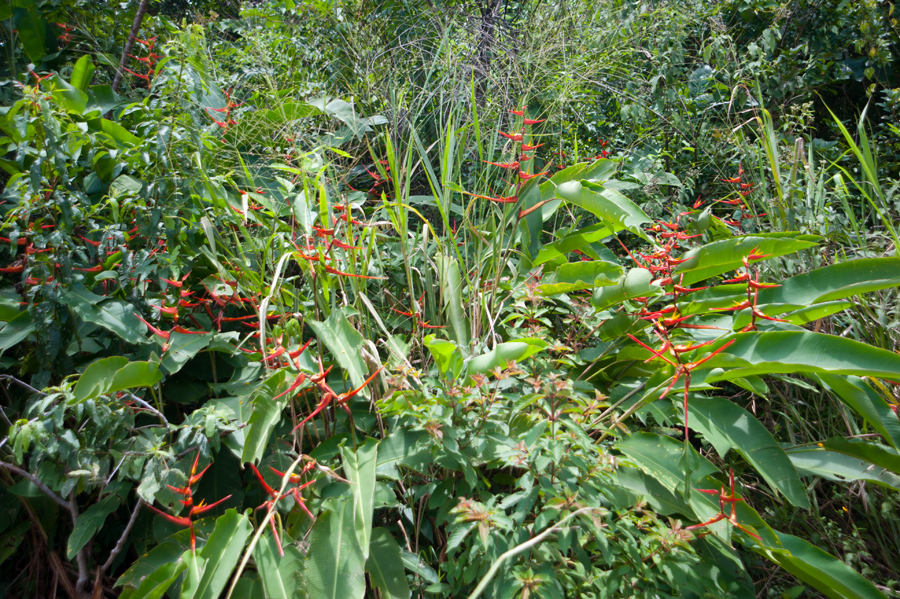
Bird of Paradise flowers grow with the weeds here in Panama (have you priced those lately at your local florist?)
The definite origin of the name Panama is unknown. I have learned there are several theories. One theory is the country was named after a species of tree, the Panama tree or Sterculia apetala. That’s a little boring. A more romantic theory: when Panama was discovered in 1501 by Spanish explorer Rodrigo de Bastidas he asked the indigenous people living here if they had gold. They told him there was no gold and these words “n0 gold” sounded to him like Panama. The most commonly accepted theory: A fishing village that bore the name “Panamá”, which purportedly meant “an abundance of fish”, when the Spanish colonizers first landed in the area. The exact location of the village is unknown. The legend is usually corroborated by Captain Antonio Tello de Guzmán’s diary entries, who reports landing at an unnamed village while exploring the Pacific coast of Panama in 1515; he only describes the village as a “same small indigenous fishing town”. The official definition and origin of the name as promoted by Panama’s Ministry of Education is the “abundance of fish, trees and butterflies”. Abundance of butterflies truly describes Panama.

